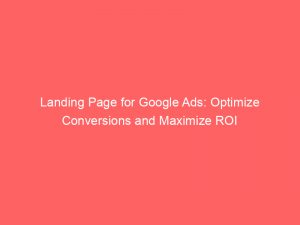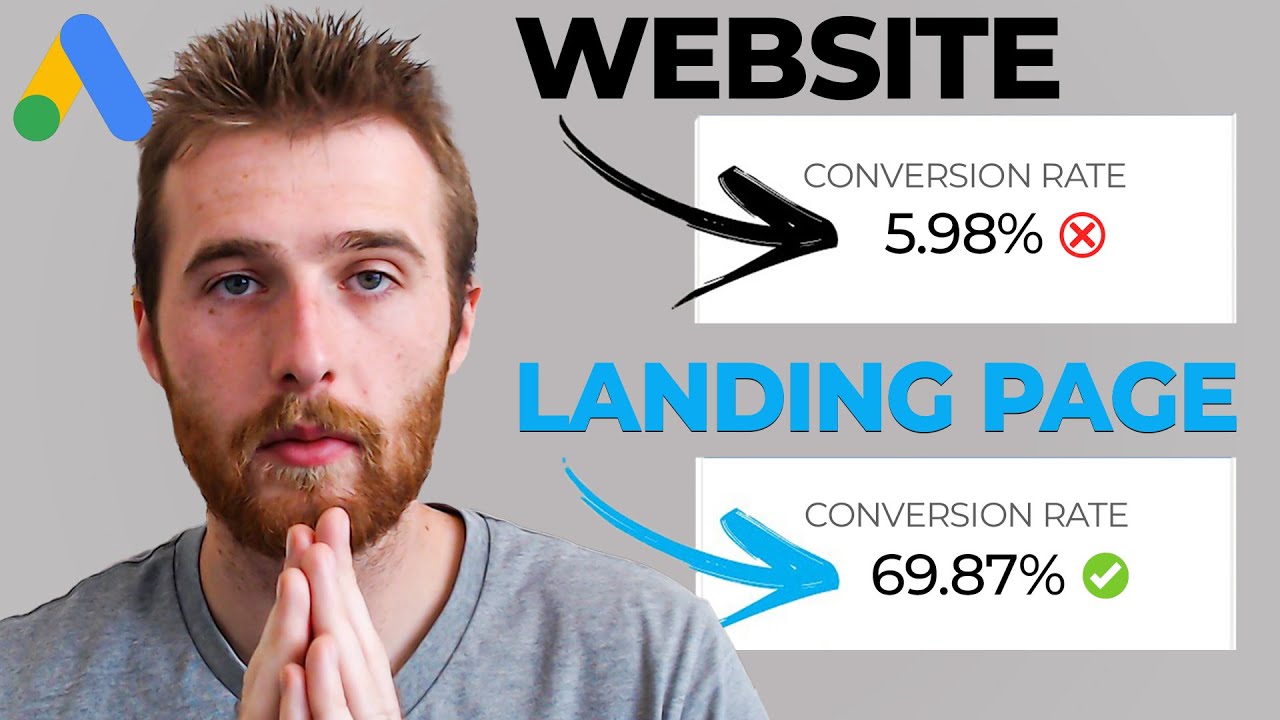- landing page for google ads
- Importance Of Landing Page In Google Ads
- Google Policy On Landing Page URL
- Impact Of Landing Page Experience On Quality Score
- Factors Affecting Landing Page Experience
- Tips For Optimizing Ads In Google Ads
- Tips For Optimizing Landing Pages In Google Ads
- Using Ad Assets For Improved Visibility And Click-Through Rates
- Mobile-Friendly Landing Pages With Relevant Content And Easy Navigation
In the fast-paced world of online advertising, capturing the attention of potential customers is crucial. Every click, every moment counts.
That’s where landing pages come into play. These powerful tools can make or break the success of your GoogleAds campaign.
They are the carefully crafted gateways that connect your ads to your target audience, enticing them to take action. But what makes a landingpage effective?
How can you ensure it meets the standards set by Google? Join us as we delve into the art and science of creating landing pages that not only drive conversions but also boost your quality score, maximizing the potential of your GoogleAds investment.
| Item | Details |
|---|---|
| Topic | Landing Page for Google Ads: Optimize Conversions and Maximize ROI |
| Category | Ads |
| Key takeaway | In the fast-paced world of online advertising, capturing the attention of potential customers is crucial. Every click, every moment counts. |
| Last updated | December 28, 2025 |
google-ads">landing page for google ads
A landing page for Google Ads is the webpage that visitors are directed to after they click on an ad. It is crucial for the URL of the landing page to match the ad’s final URL, as per Google’s policy.
The relevance and quality of the landing page experience can impact the keyword quality score. Factors that affect this experience include the relevance of the page, easy navigation, appropriate links, and meeting user expectations.
To optimize ads for Google Ads, it is recommended to sort ads based on clickthrough rate or conversion statistics, write attention-grabbing and accurate descriptions, group keywords for targeted ad creation, experiment with different ad versions, include a strong call-to-action, and highlight unique offers or promotions. Additionally, optimizing landing pages for Google Ads involves using ad assets to improve visibility and click-through rates, closely matching the landing page with ads and keywords, providing relevant content that mirrors the call-to-action, having mobile-friendly websites with easy navigation, placing important information at the top, and including useful, unique content and customer reviews to enhance credibility.Key Points:
- Landing page is the webpage visitors are directed to after clicking on an ad in Google Ads
- Matching the URL of the landing page with the final URL of the ad is important
- Relevance and quality of the landing page affect keyword quality score
- To optimize ads, sort based on clickthrough rate or conversion statistics, write attention-grabbing descriptions, and include a strong call-to-action
- Optimize landing pages by improving visibility and click-through rates, closely matching with ads and keywords, having mobile-friendly websites, and including useful content and customer reviews
- Other factors that impact landing page experience include easy navigation, appropriate links, and meeting user expectations.
Sources
https://support.google.com/google-ads/answer/14086?hl=en
https://support.google.com/google-ads/answer/6238826?hl=en
https://support.google.com/google-ads/answer/2580289?hl=en
https://support.google.com/google-ads/answer/6371202?hl=en
Check this out:
💡 Pro Tips:
1. Ensure your landing page is optimized for mobile users by providing easy navigation, clear call-to-action, and important information at the top of the page.
2. Use ad assets such as images, headlines, and descriptions to improve the visibility and click-through rates of your landing page.
3. Make sure your landing page closely matches the ads and keywords that led users to click on your ad. This creates a seamless experience and improves relevance.
4. Provide relevant and useful content on your landing page, and mirror the call-to-action from your ad. This helps to maintain consistency and increases the likelihood of conversions.
5. Enhance the credibility of your landing page by including customer reviews, testimonials, or any other unique content that sets your offering apart from competitors.
Importance Of Landing Page In Google Ads
The landing page plays a crucial role in the success of a Google Ads campaign. It is the webpage that visitors are directed to after clicking on an ad.
New insights from FroggyAds platform analytics.
The primary goal of a landing page is to convert these visitors into customers or take a specific action, such as signing up for a newsletter or making a purchase. Therefore, it is essential that the landing page is well-optimized to maximize conversions and increase return on investment (ROI).
Landing page relevance: When users click on an ad, they have certain expectations based on the ad’s content. The landing page should closely match the ad’s message and offering to ensure a seamless user experience.
By maintaining relevance between the ad and the landing page, users are more likely to stay engaged and take the desired action.
Navigation and usability: A well-designed landing page should have clear navigation and a user-friendly layout. Visitors should be able to easily find the information they are looking for without getting confused or frustrated.
Smooth navigation helps keep users engaged and encourages them to explore further, increasing the chances of conversion.
Meeting user expectations: Visitors who click on ads have specific expectations about what they will find on the landing page. If the page fails to meet these expectations or is irrelevant to the ad’s content, users are likely to become disinterested and abandon the page.
It is crucial to fulfill user expectations by delivering what was promised in the ad.
Google Policy On Landing Page URL
Google has a policy that requires the landing page URL to match the final URL of the ad. This means that the domain of the landing page should be the same as the display URL shown in the ad.
For example, if the ad displays “www.example.com” as the display URL, the landing page should have “www.example.com” as the domain.
This policy ensures that there is transparency and consistency between the ad and the landing page. It also helps users have confidence in the website they are visiting after clicking on an ad, as they can easily recognize the domain and know they are being directed to the intended destination.
Violating this policy can lead to disapproval of the ad or even suspension of the entire account. Therefore, it is crucial to comply with Google’s landing page URL policy to maintain a successful ad campaign.
Impact Of Landing Page Experience On Quality Score
The landing page experience has a direct impact on the quality score of keywords in Google Ads. The quality score determines the ad position and cost per click in the ad auction.
A higher quality score means better ad placement at a lower cost.
The landing page experience is evaluated by multiple factors, including relevance, navigation, links, and meeting user expectations. Google assesses how well the landing page provides a positive experience for visitors and whether it meets their needs and expectations.
A good landing page experience results in a higher quality score, which leads to better ad positions and lower costs. On the other hand, a poor landing page experience can lower the quality score, resulting in lower ad positions and higher costs.
Therefore, it is crucial to optimize the landing page to provide a positive user experience and improve the quality score.
Factors Affecting Landing Page Experience
Several factors impact the landing page experience, which in turn affects the quality score in Google Ads. These factors should be considered when optimizing the landing page to ensure a positive user experience:
A well-structured menu and logical layout contribute to a positive user experience.
By delivering what was promised in the ad, users are more likely to stay engaged and take the desired action.
Optimizing these factors can greatly improve the landing page experience, resulting in higher quality scores and better ad performance.
Tips For Optimizing Ads In Google Ads
To optimize ads in Google Ads and increase their effectiveness, consider the following tips:
Use catchy headlines and descriptions to capture the user’s attention.
This can involve changing headlines, descriptions, images, or calls-to-action. Continuously optimize ads based on performance data.
Use action-oriented language and place the call-to-action prominently in the ad.
By implementing these tips, you can improve the effectiveness and performance of your ads in Google Ads.
Tips For Optimizing Landing Pages In Google Ads
To optimize landing pages in Google Ads and increase conversions, consider the following tips:
This creates a consistent user experience and reinforces the relevance of the offering.
Place important information at the top for easy visibility.
By implementing these tips, you can optimize your landing pages and increase the likelihood of conversions in Google Ads.
Using Ad Assets For Improved Visibility And Click-Through Rates
Ad assets, such as headlines and images, can be used strategically to improve visibility and click-through rates. By incorporating these assets into your landing pages, you create a seamless experience for users and increase the chances of them clicking on your ad.
For example, if your ad features a compelling headline that catches the user’s attention, consider using the same headline on the landing page. This creates consistency and reinforces the message that prompted the user to click on the ad.
Moreover, incorporating relevant images from the ad onto the landing page can help users identify that they have arrived at the intended destination. It also adds visual interest to the landing page, making it more appealing and engaging.
By leveraging ad assets on the landing page, you help maintain visual consistency and strengthen the connection between the ad and the page. This, in turn, improves visibility and click-through rates, driving more traffic to your website and increasing the chances of conversions.
Mobile-Friendly Landing Pages With Relevant Content And Easy Navigation
In today’s mobile-centric world, having a mobile-friendly landing page is crucial for the success of your Google Ads campaign. With a significant number of users accessing the internet using their smartphones or tablets, it is essential to ensure that your landing pages are optimized for mobile devices.
A mobile-friendly landing page should have a responsive design that automatically adjusts to fit different screen sizes. This creates a seamless browsing experience for mobile users, preventing them from encountering issues with layout or usability.
Additionally, mobile landing pages should prioritize important information and calls-to-action. Place essential content and buttons at the top of the page to ensure easy visibility and accessibility.
This reduces the need for excessive scrolling and helps users quickly find what they are looking for.
Furthermore, easy navigation is crucial for mobile landing pages. Use a clear menu and intuitive navigation elements to guide users through the page effortlessly.
Avoid overcrowding the page with excessive text or links, as this can lead to a cluttered and confusing experience.
Lastly, provide relevant content that aligns with the user’s search intent. Tailor the information on the landing page to address the user’s needs and provide them with the solution they are seeking.
Additionally, include customer reviews and testimonials to enhance credibility and build trust.
By optimizing your landing pages for mobile devices, providing relevant content, and ensuring easy navigation, you can create a positive user experience and maximize conversions in your Google Ads campaign.
Buy Traffic • Self-Serve DSP Platform • Performance Marketing Tips • Native Ad Network











